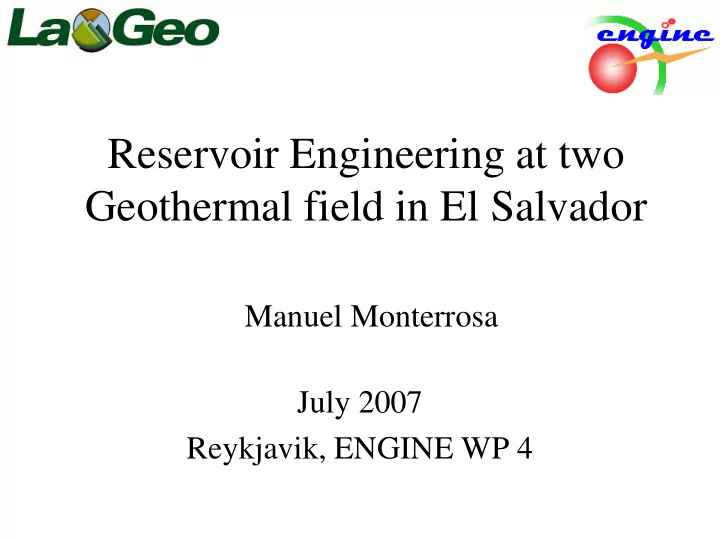

Reservoir Engineering at two Geothermal field in El Salvador Manuel Monterrosa July 2007 Reykjavik, ENGINE WP 4
Contents 1. Field and well locations 2. Production and thermodynamic monitoring 3. Well testing 4. Pressure trend under exploitation 5. Numerical modeling 6. Forecasting 7. Production enhacement 8. Conclusion
Ahuachapán Geothermal Field
Berlin Geothermal Field
Monitoring • Pressure and temperature profile in static or flowing conditions into the wells are used to know the permeable zones, flashing point, down flow, flow pattern into reservorio, pressure and temperature decline, etc • Steam yield and injection flow rate are used to correlate with the electricity production (efficiency Sustainability) • Production characteristic (Q vrs WHP) indicate the operational condition to the power plant • Chemistry of fluids (liquid, steam and gas) and steam/liquid flowrate are requiered to know which are the processes happening into the reservoir (dilution, boiling, injection return, thermal breakthrough, scaling or corrosion, mineral scaling inhibition,etc)
PRUEBA DE PRODUCCION POZO AH-35 C PRESION Y TEMPERATURA POZO AH-35C 140 TEMPERATURA (°C) 120 20 Jun 0 25 50 75 100 125 150 175 200 225 250 100 0 0 Masas ( kg/s ) 80 4 Jun 200 200 60 40 400 400 20 0 7.0 7.5 8.0 8.5 9.0 9.5 10.0 10.5 11.0 600 600 WHP ( Bar g ) PROFUNDIDAD (m) 800 800 WHP: 7.4 bar 1000 1000 19.4 kg/s Steam: Liquid: 96.8 kg/s 1200 1200 Enthalpy 1,070 kJ/kg . 1400 T.Est.5Jun 1400 T.Dinamico T.Est.13Jun P.Estatico P.Dinamico 1600 1600 0 10 20 30 40 50 60 70 80 90 100 110 120 PRESION (Bar)
Discharge test well AH-35C Junio 20th, 2007
Mass and pressure historical trend, Ahuachapán Field 40 3000 AH25 Pressure at +200 m asl Extracted Mass 35 2500 30 2000 Pressure [bar] Mass [T/h] 25 1500 IV I V 65 MW 20 1000 II III 80 MW 50 MW 50 MW 15 500 Not injection Operation w/injection 10 0 1975 1978 1982 1986 1989 1993 1997 2000 2004 2008 2011
Power production and Pressure, Ahuachapan field
Mass and pressure trend at the Berlin Field 45 900 40 800 35 700 U1 and U2 30 600 U3 Masa total (kg/s) 25 500 bar 20 400 15 300 10 200 5 100 0 0 06-Dic-99 05-Dic-00 05-Dic-01 05-Dic-02 05-Dic-03 04-Dic-04 04-Dic-05 04-Dic-06 04-Dic-07
Numerical modeling for the Ahuachapán field
Numerical modeling for the Berlín field Simulation from the beginning to year 2026 Liquid Phase Measured produced liquid 3000 150 Steam Phase Measured produced steam Pressione TR5 @ -1150 Reservoir Pressure at -1150 mbsl 2500 125 2000 100 Pressure [bar] Flow Rate [t/h] 1500 75 1000 50 500 25 0 0 1992 1997 2002 2007 2012 2017 2022 2027 Years
Production enhancement • Due to mud damage or 100 naturally self sealling 90 formation, permeability in the feed zone could be 80 lower than the expected 70 one 60 • To enhance the steam kg/s 50 production acid injection could be used. 40 Vapor Pre • In 2006 well TR-5B was 30 Total Pre Vapor Post stimulated using 38 m 3 Total Post 20 HCl as preflusing and 57 10 m 3 of HCL and ammonium bifluorine 0 5 10 15 20 25 30 bara
Conclusions • The monitoring is the best way to gatter information from the wells and the whole geothermal system. • Reservoir engineering technics contribute to welldone field management and the sustainable resource utilization. • There are several way to increase the energy yield from the reservoir: pressure declining, steam enhance by acid or hidrofracturing estimulation, drilling make up wells, etc.
Recommend
More recommend